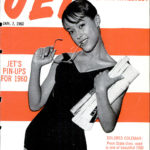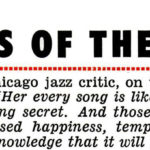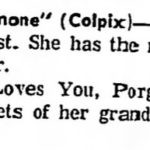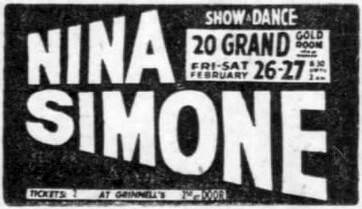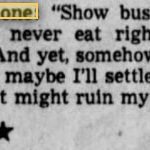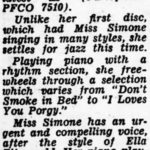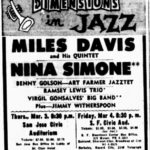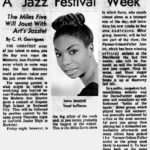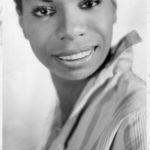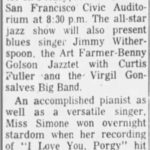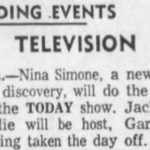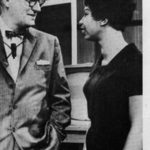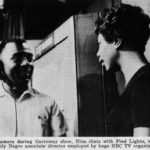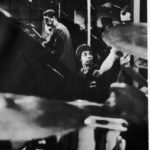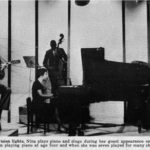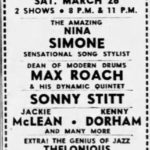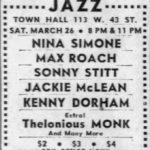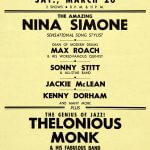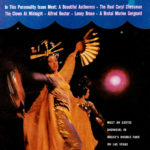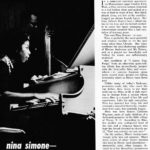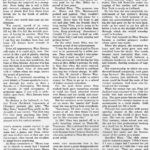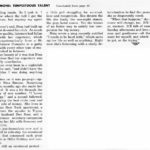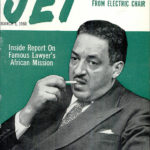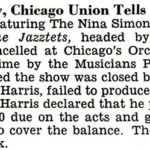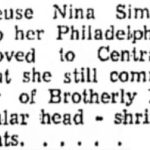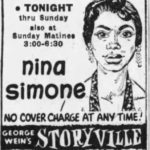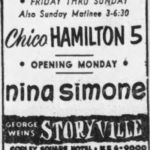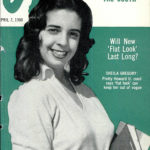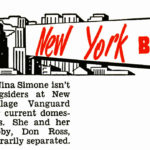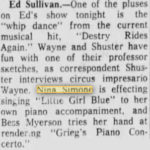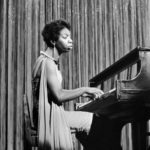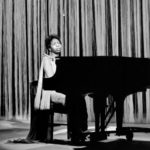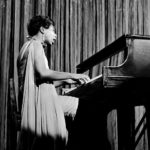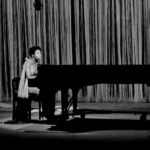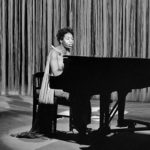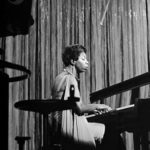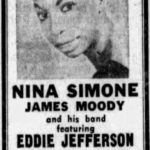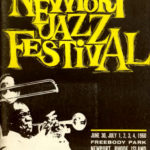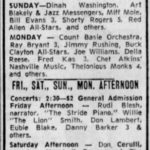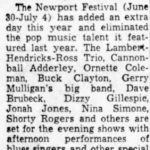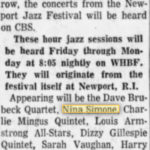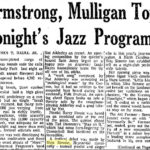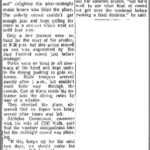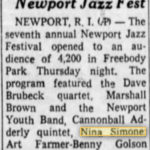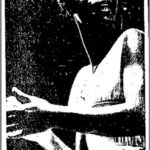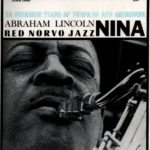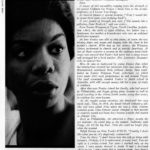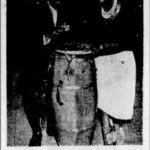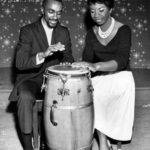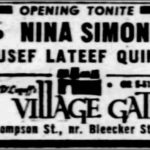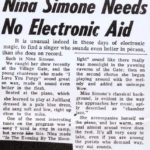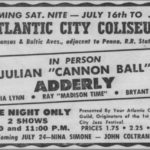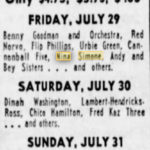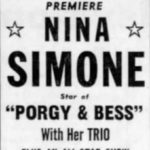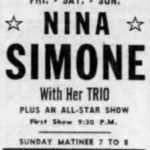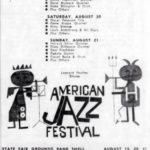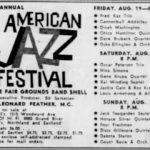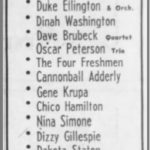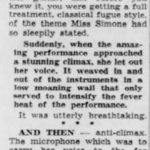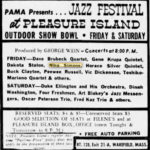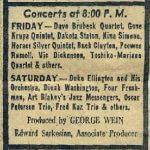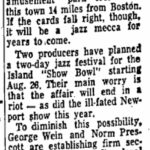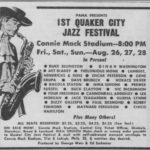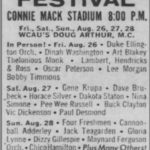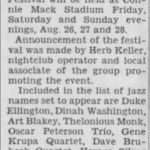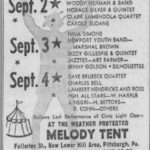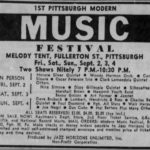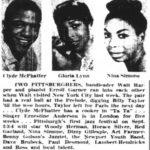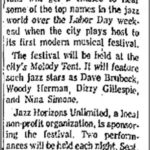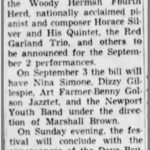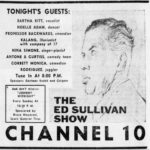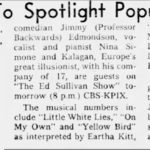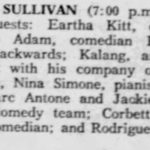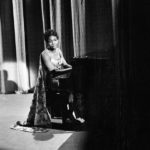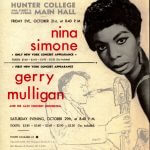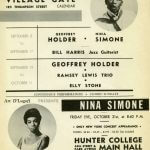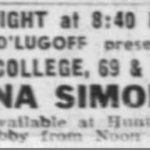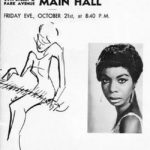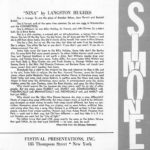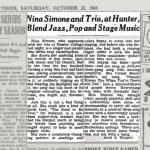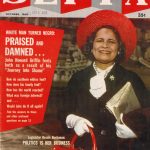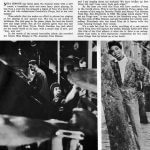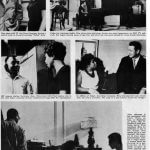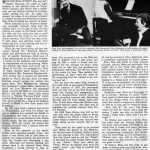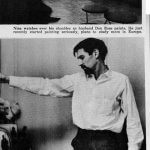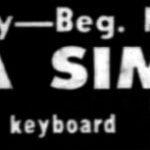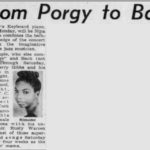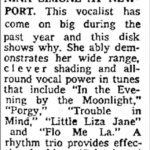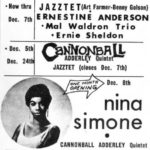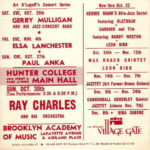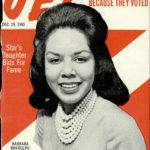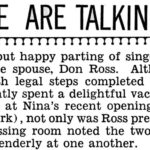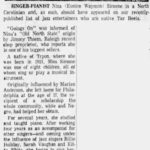1960
A memory of sadness, a tone of the delta in her voice. When “I Loves You, Porgy” plays, everyone goes silent.
A cauldron of complexes, beginning to boil, an intro to
Nina Simone — tempestuous talent
In a dimly-lit railroad apartment on Manhattan’s upper Central Park West, a lithe, nervous woman slouched in a red leather chair and picked at a tray of food in front of her. Her black sheath dress, cut low at the neckline, hugged an almost boyish figure. Her long, delicate fingers beat a silent tattoo on the tray and she talked excitedly to cover her inner tenseness; her conversation sounded like a bad recitation of Joycean prose.
This was Nina Simone — at ease.
Nina is probably the most powerful and original vocalist to hit the jazz scene since June Christy. Her voice combines the soul-shattering qualities of Marian Anderson and Ma Rainey, and as a pianist her knowledge and feeling for music are suffocatingly profound.
Her rendition of “I Loves You, Porgy” from an otherwise quiet-selling album has miraculously jumped onto the best-seller lists, and everywhere — in campus hangout, pizza joint, record shop — people are falling reverently silent as Nina’s voice flows past.
Unlike many of today’s flash-pan, promotion-made hits, who reach the top before they learn to put their makeup on, Nina, at 26, is only starting to emerge from a cocoon whose every fiber is a strand of her life and experience. Like the ugly caterpillar, Nina has shucked her fuzzy lair and emerged a beautiful butterfly, resplendent with color, but painfully fragile.
Nina was born Eunice Kathleen Waymon, sixth of eight children of a dedicated preacher in the little village of Tryon, NC. According to Nina, her mother was undisputed head of the clan and a religious fanatic who kept the brood closeted in church until, “God was coming out our ears.”
On the surface, Nina’s background, though grim was not unusual. There were scores of other Negro families like hers in Tryon (and elsewhere) — shamefully poor, often hungry, devoted to a few threadbare possessions and passionately convinced that God was the man with the big candy cane who would pluck his children from misery and deliver them to Heaven if they could only endure their earthly sufferings with dignity and devotion.
To Nina, the grin-and-bear-it attitude of her people was an unbearable weight which crushed every humane instinct. The poverty and privation ground her spirit to dust and she shrunk away inside herself to hide from the ugly world around her. She became shy and afraid and unconsciously turned to music as an outlet for her pent-up feelings.
Her emotional life to follow was simply an extension, with variations, of the feelings she acquired as a youngster. Even today she is still a little girl — twisted, unhappy, plagued by an army of ghosts that four times have driven her to the bring of self-destruction.
Nina’s own words best sum up her dilemma:
“I’m scared, scared of so many things, but mostly scared of poverty. All my life I’ve felt the terrible pressure of having to survive. Now I’ve got to get rich…very, very rich so I can buy my freedom from fear and know I’ll always have enough to make it.”
From all appearances, Nina Simone will make it in rapid style, now. Her career is like a pot of gumbo, starting to seethe at the edges, ready to boil over. It is no long shot prediction, the fame of Nina Simone. Anyone who has seen the look of comprehension on otherwise blank faces of teenaged rock n’ rollers when she sings, knows the sound of greatness.
There is a universal something in great talent; a Picasso speaks to everyone through his work, as does a Brando, or a Hemingway. The stamp of success, of total acceptance, of greatness again, if you will, is undeniably upon them. Nina Simone bears this stamp.
So obvious is the hallmark, in fact, that Frank Holzfeind, impresario of Chicago’s premier jazz joint, “The Blue Note,” booked Nina solely on the strength of one record. “The first time I’ve ever done anything like that,” commented Holzfeind, obviously pleased with his radical actions.
Nina’s musical career started at age four. Poor as they were, the Waymons had a piano, and Nina, whose gift was evident even at that age, was encouraged, often forced, she recalled, to spend hours practicing.
As Nina remembers it: “Mama kept me in church so much that I learned all the religious music by heart. Mama loved to hear me play those songs but when I started to mess around with boogie-woogie she’d get furious. She got so bad that I had to slip off to school and use the piano there.”
At the glorious age of seven Nina gave her first concert — a all religious program — at a little theater in the Negro section of town. It was the turning point in her life.
Seated in the audience were two white women from uptown — Mrs. Lawrence Mazzanovich, a music teacher, and Mrs. George Miller, a matron for whom Nina’s mother occasionally worked as a maid. Both recognized Nina’s talent and after the concert, arrangements were made for Mrs. Mazzanovich to give Nina piano lessons paid for by Mrs. Miller for a period of two years.
Recalled Nina: “The pressure was on. Mama and Mrs. Mazzanovich pushed and pushed. They wouldn’t let me away from that piano for a minute. Every time I’d want to get out and play with my friends they’d keep saying ‘Nina, you’re going to be great. You’re going to be better than them. Keep practicing.’ Sometimes I thought I’d go crazy locked up with that piano but I just kept playing and getting better.”
One the other hand, Nina was immensely proud of her achievements.
“I was the first colored girl in Tryon ever to be sponsored by a white person. They really thought I was something and it made me feel great.”
Nina performed well during her two years as Mrs. Miller’s protege. So well, in fact, that when the grant expired, Mrs. Mazzanovich offered to continue teaching her without charge. In addition, Mrs. M. Started a Eunice Waymon fund in Tryon in order to collect money for Nina to go on to a school of higher musical education.
For the next three years Nina studied hard, gave numerous recitals to build her fund, attended church with Mama and the family and maintained a straight-A average in school.
But her emotions were beginning to act up under the “special kid” treatment she was getting from everybody.
“Sometimes I’d start crying for no reason at all. At other times I’d want to give the whole damn thing up and just be like everyone else.”
In 1945 Nina was packed off to a girl’s boarding school in Asheville. She continued her musical education for the next three years with Russian-born Clemens Sandreski, who also spotted in Nina the germ of a great artist.
When Nina graduated first in her class she faced a great disappointment. She was forced by her mother to turn down a scholarship to college in order to continue her musical studies.
“That almost broke my heart,” she said. “I was so proud of being smart. Going to college was something I’d never dreamed of. It was something I’d earned all by myself.”
About her music, Nina said: “I hated it. It wasn’t mine. I was beaten with it by Mama and all my music teachers. Music, music, music, music, music — that’s all I heard from them. I wanted to cut my fingers off so I would never have to play that again.”
Nina recalled that music ate through the fiber of her life like a cancer eroding everything in its path, leaving no room for love, fresh air, or happiness.
Broken-hearted, angry, and frustrated, Nina left Asheville under the urgings of her mother and went to New York to study at Juilliard.
By this time she was completely the instrument of her mother’s driving ambition. In a brief moment of insight, she acknowledged it and realizing she had gone too far to turn back, made up her mind to use her gift to batter a hole in the skylight of her life through which she would someday crawl to freedom.
From that moment on Nina Simone became a red-hot pressure cooker whose spout was music.
When she played, she smashed the keys, and her arms grew taut and trembled from the strain. Her moods became more mercurial than ever, sliding back and forth between a sulkiness bordering on the moribund and frenetic, fleeting ecstasies of happiness.
Her musicianship, to which she now devoted herself completely, took giant steps forward. She played everything: the classics, jazz, spirituals. In her music could be found the scale of her twisted emotions. And those who listened got the message.
When the money ran out, Nina left Juilliard and returned to live with her family who had moved to Philadelphia. She gave piano lessons and later implemented her meager income as an accompanist in a vocal studio. Both jobs grossed her $45 a week.
Through her association with young inspiring singers at the school she slipped into the world of show business. She met an agent. He flipped. That summer, when school was out, she got her first professional booking at a bar in Atlantic City.
Two things happened then. She changed her name and she became aware of her power as a singer.
Recalled Nina: “The club owner said he wanted a singer. I didn’t know if I was a singer but I wanted the job at $90 a week so I told him I was and he hired me. Then my agent said ‘Baby, you’ve got to change your name. Nobody’ll buy Eunice Waymon.’ So I thought and thought, and I guess how I came up with Nina. I had a Spanish boyfriend at the time and he’d always call me Nina, which means little girl in Spanish. When he called me by that name it always gave me a warm feeling inside. So I took it. I don’t know where the hell I got the Simone from, but anyway my agent liked it.”
By summer’s end, Nina had built up a small but devoted fan club. As much as with her quality, listeners had fallen in love with her repertoire, which ranged unsystematically from a 45-minute Warsaw Concerto to a gutty spiritual with every other type of music sandwiched in between.
The great beauty of it was that Nina had no notion that her repertoire was particularly unorthodox.
“I’d never even been in a nightclub before,” she said, “and didn’t have the slightest idea I was doing anything different.”
From then on it was go-go-go up-up-up for Nina Simone. Something over seven months ago she made her first record. It was a hit through the popularity of one number, “I Loves You, Porgy,” and a second followed. She’s playing the best clubs now and making a pile of money. She lives in a luxurious New York apartment, a far cry from the squalor in Tryon, with her husband Don Ross, and a blonde woman secretary-companion who guides her life with firmness and determination.
She’s in psychoanalysis now and is determined to side-step the emotional snake pit that consumed such great jazz artists as Billie Holiday and Lester Young.
Nina is still an emotional pretzel — a little girl struggling for survival, love, and recognition. She detests the life she leads, the one-night stands, the grey hotel rooms. Yet she knows of no better way to satisfy her compulsion for big money.
Nina wrote a song recently entitled “I needs to be beed with,” which sums up her life as well as anything. Right now she’s brimming with a steely determination to find the peace of mind she so desperately needs.
“When that happens,” she said, “my music will change, too. It’ll be sweeter, warmer. It’ll talk of rosebuds and Sunday afternoons and love and kindness and gentleness — all the things I want for myself, and which I’m going to get, or die trying.”
NINA simone
Tense, taut, sensitive, religious, intelligent.
Rare.
A singer of rich versatility, ranging from the strength of the gospel “Children Go Where I Send You” to the secular poignancy of “I Loves You, Porgy.”
A classical pianist of special promise (“Now I would like to spend three years just studying Bach”).
A jazz pianist of strength and style (“She sounds like a galloping Dave Brubeck,” said one critic).
Born Eunice Waymon in Tryon, North Carolina (population 1,985), the sixth of eight children, her father was a handyman, her mother a housekeeper who was an ordained Methodist minister.
At four Eunice was able to play piano; at seven shew as playing piano and organ and singing with the choir in her mother’s church. With two of her sister, the Waymon Sisters performed in church and at outside functions. At one of these concerts a woman in the audience went backstage, was amazed that Eunice had never had a piano lesson and arranged for a local teacher, Mrs. Lawrence Mazzanovich, to instruct her.
Mrs. M. Was so impressed by young Eunice that when the benefactress stopped her payments after two years, Mrs. Mazzanovich continued them without charge, then established an Eunice Waymon Fund, collections for which were made after each performance in and around Tryon. The fund eventually enabled Eunice to finish school in Asheville, with still enough money left for a year of study at Juilliard.
After that year Eunice joined her family, who had moved to Philadelphia, and began giving piano lessons as well as vocal coaching at the Arlene Smith studio, using that money to continue her own lessons.
As she taught young vocalists, she developed her own vocal style. Then, in 1954, she found herself without a job. She had been called Nina when she was a child. Simone sounded good. Nina Simone (named changed so that parents of students would not know her) became a night club pianist in Atlantic City.
Back in Philadelphia, she attracted a clique, mostly the art students; she could play as she wanted. Suddenly, with Porgy, she hit the big time. Then she could no longer play what she wanted.
Ralph Berton on New York’s WNCN: “Frankly I don’t like what you do; it’s stagecraft, commercial.”
Nina the Rare: “I don’t know how this will go down with listeners. Perhaps, if it is understood, it won’t hurt. You are right to a certain extent. For years I have worked only on my music. I very nearly starved to death. It had a profound effect on me. I don’t want that to happen again. Sure there’s staging and commercialism now. When I don’t have to worry about food, about money and rent, then people will hear the real Nina Simone. I can promise you that.”
Rare? Bethlehem, now Colpix, might show you why. The story itself is exciting, revealing, an American one: the rareness that Nina Never Knew but Eunice had the many different kinds of fortune to know.
LITTLE GIRL BLUE
Nina Simone, the bluesy gal who whispered “I Loves You Porgy” is still sighing sadly.
Nina Simone has burst upon the musical scene with a new sound, a breathless style and some fancy piano playing. In less than a year she has amazed a legion of fans who know her as the girl who rediscovered Gershwin’s Porgy, but in her own manner.
Nina admits that she makes no effort to phrase her singing or her playing in any special way. She has no set notion of technique. She just goes to the piano, plays the best she knows how and sings softly. But all the experts agree that this tall dark brown girl from Tryon, North Carolina has just about set the music world on its ears, with a sound that is new and ‘way, way out.’ In the words of the second best-seller album she recorded for Colpix, Miss Simone is The Amazing Nina Simone.
The song Nina is best known for is I Loves You Porgy with she made as a single and which has come to be known as her theme song. In this song Nina pours her heart out for the man she wants but who she knows is no good for her. In the haunting blues melody, almost heartbreaking in its rendition, Nina sends out feelers that find a ready understanding in her audience.
“That’s because I am singing about myself,” says Nina, “and I think my audience realizes this too. This song is for real and I am singing about my husband. We have broken up five times but can’t keep away from each other.”
By the time you read this Nina will have another Porgy in the record stores. This is not the Gershwin Porgy again, but a version of the song by Dorothy Fields and Jimmy McHugh from “Bye, Bye Blackbirds” in 1928. The song, which starts “I’ve got my Porgy now,” is very close to the Gershwin’s song. Its mood fits the style of Miss Simone, sad and mournful but utterly compelling. Everybody who has heard Nina do it leaves with the song running through their minds.
It’s a safe bet that for a while, anything of a sad nature which Nina does will capture her public, because Little Girl Blue (the title of her first album) is what she is. Hers is an unhappiness that seeks to find expression — expression for the numerous things that lie locked up in her heart.
How did Nina start? She was born Eunice Waymon, the sixth of eight children in the obscure town of Tryon, North Carolina. Her father was a handyman and her mother worked as a housekeeper during the day. At night she donned the robes of an ordained minister to conduct services for Methodist churches. Here Nina developed her interest in music.
While everyone in the Waymon family was musically inclined, Nina had the earliest start. At the age of four she was picking out songs on the family piano. By the time she was seven she was so good she played for the choirs in her mother’s church services. Thus Nina had deep roots, in both blues and spiritual music. This comes out now in her playing and her interpretation of most songs.
When she was about seven, she and two sisters formed the “Waymon Sisters” group and performed not only in church but at outside functions. After one of these performances at the Tryon Theatre, a woman in the audience went backstage to congratulate her on her playing. When she learned that Nina had never had a lesson in her life, she arranged for Nina to begin classical piano lessons with a local teacher, Mrs. Lawrence Mazzanovich.
This woman was to become an important factor in Nina’s life, for when her benefactress ceased paying her tuition two years laser, Mrs. Mazzanovich, realizing the youngster’s great talent, continued to teach her free. Moreover, she organized small concerts for Nina at civic and social affairs and with the money thus raised started a “Eunice Waymon Fund” which enabled Nina to go to high school in Asheville and to study for a year at the Juilliard School of Music in New York under Carl Friedberg.
By this time Nina’s parents had moved to Philadelphia, and when her money ran out a Juilliard, she rejoined her family in Philadelphia and went to work as an accompanist for vocal students at the Arlene Smith studio. She also gave private piano lessons. With the money she earned she studied privately with a teacher from the Curtis Institute.
Most of the students at the Smith studio were studying popular music, and since it was Nina’s job to help them interpret the songs properly, she soon found that she herself was developing a pop style. Although her formal training had always been in the classical idiom, Nina developed a strong interest in jazz, as well as for improvising. She would improvise on classical music, spirituals and popular tunes. She was also influenced by listening for hours to Nat Cole, Billie Holiday, Kitty White, Louis Armstrong and others.
In the summer of 1954, Nina found herself without a job as all the students had gone on vacation and the studio had closed down. She accepted a job at the Midtown Club in Atlantic City to play piano and sing for $90 a week — a brand new departure for her. Despite her fears, Nina made out so well that she developed an enthusiastic following. She did not return to the studio for long. Nina decided that performing, at least until she could do the composing that she wanted to, was the best bet.
For the next two years Nina worked in the small clubs in and around Philadelphia. In the summer of 1957, she performed with her own trio at the New Hope Playhouse Inn. During that engagement, he made a demonstration record which led to her recording contract with Bethlehem Records and her first album, Little Girl Blue. It was there Nina met Bertha Case, a noted literary agent, who later was to negotiate her current contract with Colpix Records.
Nina came by her name in an unusual way. When she played at the Midtown, she did not want the Smith studio to know she was playing a club. She remembered a boyfriend used to call her ‘Ninia’, so she used the name. People didn’t bother to say ‘Ninia’. They just called her ‘Nina’. Where the Simone came from she doesn’t know: only that it sounded well with Nina.
Now 27, the slim girl with the large, expressive black eyes has the bookings pouring in. Between stints she tries to rest and practice on the 15th floor of an apartment building overlooking Central park in New York, where she lives with her husband, a Philadelphia born drummer named Don Ross, who is now painting in oil, and her secretary, Faye Anderson, who is simply captivated by Nina’s talent.
Since Nina has depth in three spheres of music — classics, blues, and spirituals — Don thinks this is the thing that gives her such an unusual sound. Says he: “She has a tremendous reservoir of training and this training combined with modern material gives, in effect, a particularly majestic feeling in a framework of modern jazz.”
If it can ever be explained, this is the best explanation so far of Nina’s elusive style, which can be felt, but seems to escape any description.
Sometime soon, Nina and Ross plan to go to Europe, “perhaps for good.” There they expect to find some peace and repose to do the things which they want to do most. She wants to compose in the classics as well as in jazz and he wants to paint.
“Let’s face it,” she says, “I’ doing what I do now for money, and I hope the money I make can help me achieve the things I really want. Right now I am not happy.”
An intense and sensitive person, Nina has more than the average feeling for her work, and a broader knowledge of the world than is found with many performers. She suffers easily and is filled with an overpowering compassion and tenderness for everything. As her husband says, “France may very well be the catalyst that makes us find ourselves and realize our goals in life.”
In France, Nina and Don hope to get down to serious study and hard work. Also, they hope to find a better perspective on their marital troubles. In other words, they are looking to their stay abroad with “great expectations,” they say.
Until they leave, however, Nina Simone will be giving pleasure to thousands of fans all over the country who may not know what her goals are, but dig the most what she is doing now.

